Cost Effective Suction and Drainage using Mucus Sucker
Shankar Ram HS1, Ullal Anand Kini2, Sagar HC3, Loka Vijayan SK4
1 Resident, Department of Surgery, Kasturba Medical College, Mangalore, India.
2 Associate Professor, Department of Surgery, Kasturba Medical College, Mangalore, India.
3 Resident, Department of Surgery, Kasturba Medical College, Mangalore, India.
4 Resident, Department of Surgery, Kasturba Medical College, Mangalore, India.
NAME, ADDRESS, E-MAIL ID OF THE CORRESPONDING AUTHOR: Dr. Shankar Ram HS, Resident, Department of Surgery, Kasturba Medical College, Mangalore-575001, India.
Phone: 919447737206, 917760050154,
E-mail: ram.hss83@gmail.com
Mucus sucker, Vaccum, Drain
Dear Sir,
The usage of mucus sucker for suction drainage has been introduced and practised in Department of Plastic Surgery, Madras Medical College, Chennai. This idea has been followed by surgeons who were trained in this college. Despite its function, which is similar to that of Jackson Pratt’s drain, there is no review of literature on this particular usage, which remains unknown and surprising to many. Here, in KMC, Mangalore, mucus sucker has been used in few surgical units for almost three decades.
Mucus sucker is made of red rubber. It is readily available, very cheap and it can be autoclaved. It is compact and portable and it can be carried in a concealed manner, under the clothing. Its cost varies from 30 to 50 rupees (less than a US Dollar). It is available in 3 standard sizes; 30 ml, 60 ml and 80 ml. The negative pressure amounts to 60-80 mm Hg on complete evacuation, which is the same pressure which is obtained in other suction drainage systems [Table/Fig-1,2].
Measurement of maximum negative pressure of Romovac suction showing 70 mmHg
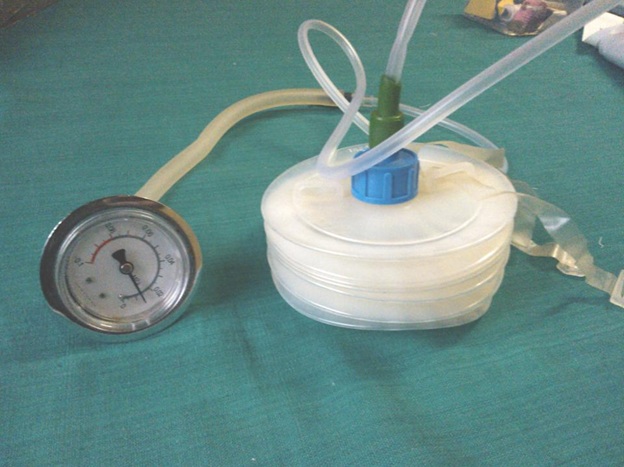
Measurement of maximum negative pressure of mucus sucker showing around 70 mm Hg
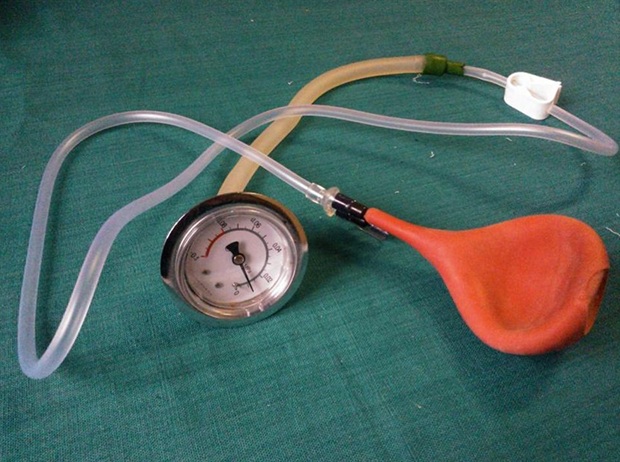
Drainage is done by using an intravenous drip set [Table/Fig-3] or a suction catheter (with multiple fenestrations made) or an infant feeding tube. The cut open section of mucus sucker has been shown in [Table/Fig-4].
Mucus sucker fitted with Intravenous drip set tubings at both ends and suction catheters
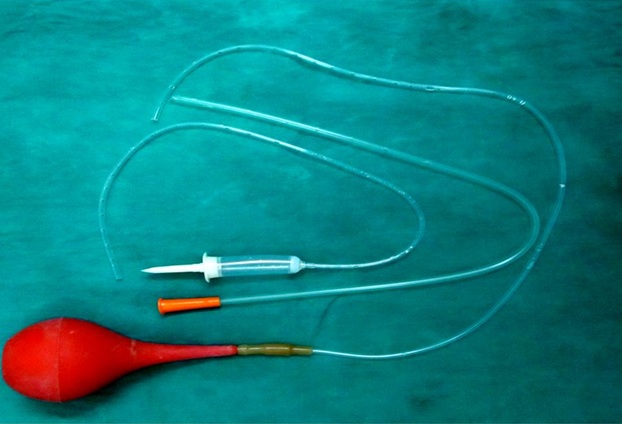
Internal view of mucus sucker
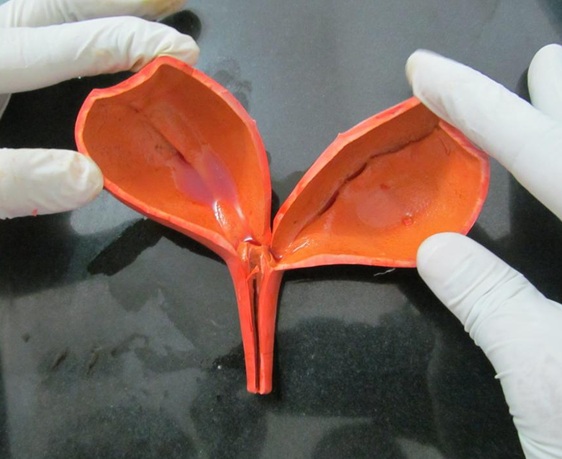
The drainage tubing is fitted to the nose of the sucker after charging. Sometimes, the drain outlet site might require a suture to prevent a minute steady leak. Another advantage is that the length of the drain tubing can be adjusted. The contents can be disposed intermittently and easily, with a gentle squeeze. The drain is kept for 5-7 days till the contents reduce in quantity and are serous. Patients and bystanders can be taught to use it, in case the drain has to be managed at home, after discharge of patients from the hospital. There are only few instances of delayed blockages caused by the exudates and fibrin plugs and once they are properly placed, the occurrence of leakages is uncommon.
The mucus sucker is used commonly for limb amputations, parotidectomies, modified radical mastectomies, mammoplasties, abdominal wall procedures, incisional hernia repairs, degloving injuries of arm, inguinal hernia repairs, thyroidectomies, neck dissections, myocuteneous flaps following wide local excisions of swellings, Jaboulays procedure, inguinal block dissections,minor surgeries like fasciotomies,haematoma evacuations and abscess drainages, as shown in [Table/Fig-5,6].
Use of mucus sucker drain in head and neck ,breast , abdominal wall and other minor procedures
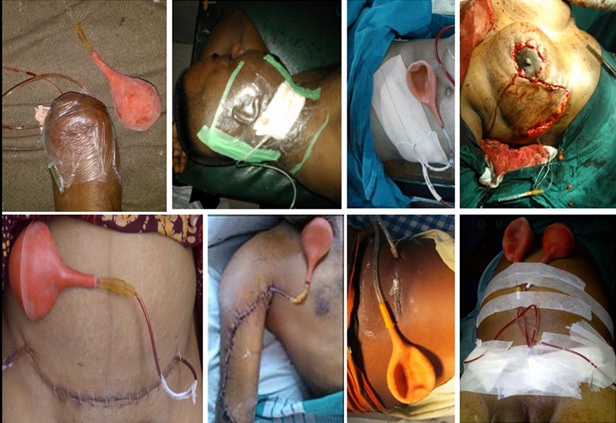
Use of mucus sucker drain in Thyroidectomy, following excision of swelling in limb, back and inguinal block dissection
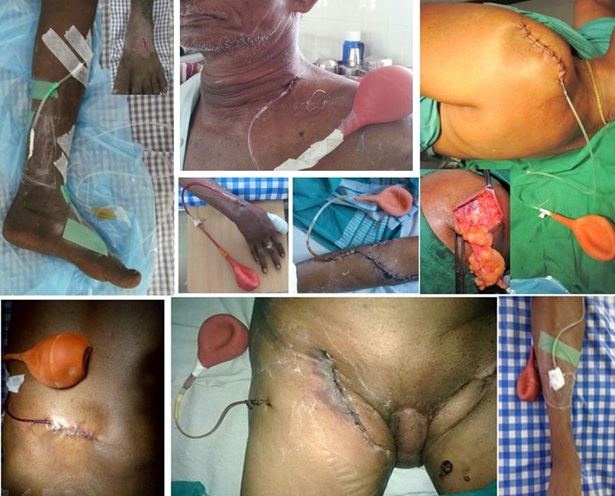
The use of mucus sucker in vacuum assisted closure of small wounds is shown in [Table/Fig-7]. Closure of wound dehiscence (a wound which was covered with sponge and sandwiched by opsite) is shown in the picture. A digit with partial amputation healed well after oedema was reduced by suction. Healing of small wounds and ulcers and closures of abscess cavities following incisions and drainages were possible. The opsite placement was aided by T tailing [1].
Use of mucus sucker drain in healing of small wounds with principles of vacuum assisted closure
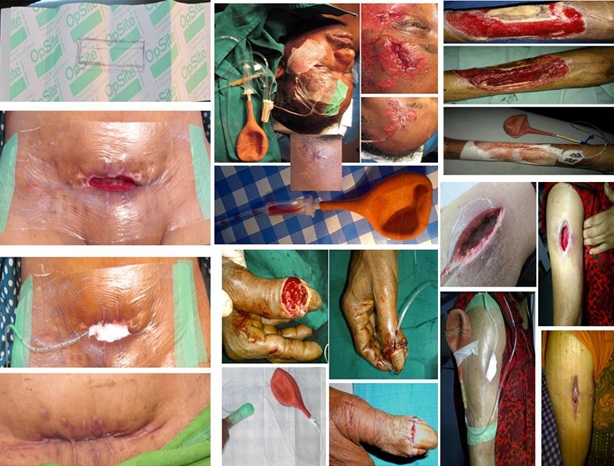
The main aim of this brief communication was to highlight the various uses of mucus suckers in surgical practice. The recognition and trial or routine use are totally up to the users’ preferences. The acceptance has been very good in government as well as corporate setups.From our experience, the results are gratifying, with simplicity of its working design,efficacy and cost effectiveness.
[1]. Ram S, Vijayan SKL, Kini A, Tail T, Configuration Of Opsite On Suction Tubing Outlet For Modified Vacuum Assisted ClosureThe Internet Journal of Plastic Surgery 2012 8(1) [Google Scholar]